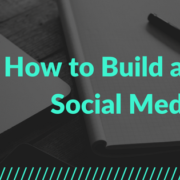Choosing Influencers for Client Campaigns
I feel the need to demystify something about the process of choosing influencers for client campaigns. It may surprise you, but at Everywhere, we do not crowd around a conference table, look at the slate of applicants and pick our personal favorites. We all had our fair share of suffering on behalf of the “populars” during our respective high school years, and even though we can recite the majority of the “Mean Girls” script by heart, we don’t make our choices based on who we’d let sit with us. In fact, which influencer to pick for a campaign is ultimately driven by the client.
So how does it work? Have you ever heard the old saying, “There are two things you never want to see being made: laws in congress and sausages”? Well, it’s about as complicated as that – although as an agency we’ve tried to streamline the system to avoid the messiness.
When we launch a campaign with a client, we review their goals, and identify what success will look like. At Everywhere Agency, we also use a platform we’ve built called InfluencerConnect™ to help us sort and match influencers based on their profiles. Each client has different wants and needs based on their target demographics, so we review their priorities as follows.
- Theme: What does the influencer blog about? If we’re doing a fashion campaign, sorry, we don’t need food bloggers,(even if your outfits slay on the regular). If we’re doing an entertainment-related campaign, we need to find folks who write and post about that topic on social media frequently.
- Quality of Content. We read your blogs – not just the front page, but we scour your blogs. We stalk influencers and review their content going back months and months. We have one client that is looking for gorgeous images – they like to repurpose influencer content on their own channels, so we’re really looking a the quality of photography. If it’s a content-heavy post, we’ll pull samples of your writing style to show the client. Most clients have non-competes, so if we’re working for Coca-Cola, but you just did a campaign for Starbucks, you’re out. Some clients are averse to anything overtly religious or political. So, if you’ve mouthed off about the recent political happenings in our country, you’re out. I’m not suggesting influencers censor their content – just be aware that some clients shy away from content that is overly opinionated.
We also look to see if influencers have a natural affinity for the brand. Would you write about the brand even if you were not paid? Does the brand relate to the type of content you share? Our clients are Macy’s, Carter’s, OshKosh, Cox Communications, Mattress Firm, and others. These are products and services you’ll find in everyday American households. When choosing influencers, we look at your content to see whether our brand content is a fit.
- Audience & Location: If you’re a member of Everywhere Society, you know we often ask, “Where are the majority of your readers based?” We do a ton of hyper-local campaigns for Macy’s. Fantastic for you that you have readers coast to coast and in Canada, but not so great for a location-specific campaign. This is where we can often book influencers with lower numbers because we’re really looking for hyper-local readers.
It also matters where you personally are located – which might not be where your readers are concentrated. When we worked with Orkin, we needed influencers who wrote about entertaining and outdoorsy activities and were based throughout the Southeastern United States. So imagine, when we are reviewing influencers and we have three great candidates based in Miami, somebody is going to have to take the cut because we have to ensure we’re reaching other parts of the region. Typically, reach and audience will be the deciding factors – not who we like best.
- Platform. What’s your primary platform? For super visual campaigns, we may need an influencer who has amazing Instagram numbers even though his or her blog UMVs are just so-so. We sometimes look at the totality of the platforms where you create content, and other times, we’re really just looking at one specific platform. Last year, we had to source a millennial SnapChat influencer for Cox Communications for a very specific region of the country..
- Reach. Yes numbers matter, but they aren’t the end-all, be-all. Some clients want us to source celebrity influencers, but that’s the rarity, not the norm. Today, more and more of our clients want to deploy multiple micro influencers for campaigns. So yes, numbers matter but blog UMV’s are no longer the holy grail. Your Instagram or Facebook audience may be just as impressive to a client as your blog readership.
- Demographic. Some of our client campaigns are focused on a specific demographic: entrepreneurs, baby-boomers sending kids to college, moms of newborns, parents who are raising their children bi-lingual. We narrow down those demographics in our search for influencers.
- Above & Beyond Influencers. Once we’ve evaluated all these different quantifiable categories, we can consider what we at Everywhere Agency know about you the influencer. We call this the “Above & Beyond Factor.” We love influencers who repeatedly exceed expectations on client campaigns. They don’t just get their links in on time, they create awesome content, they ask questions, and they show true passion for the brand. Yes, many campaigns have bumps in the road that we have to work through, but it’s the working relationship with you that matters at this point.
Our InfluencerConnect™ platform helps us weigh what’s important to the client, but we can’t just rely on technology. We read your work, and we provide detailed notes on why we’ve recommended you. We make strong recommendations for influencers who we think will be a great fit, and sometimes we fight for you. But even though we are in your corner, at the end of the day it’s the client’s choice as to which influencers they will use for a campaign.
So, to any influencer who has not “been picked” for a campaign in a long time, it’s not because we don’t love you. We (heart) all our Everywhere Society members – that’s why we invited you to join in the first place! It’s not personal, nor is it the luck of the draw. It’s just complicated and a little bit like making sausages.




